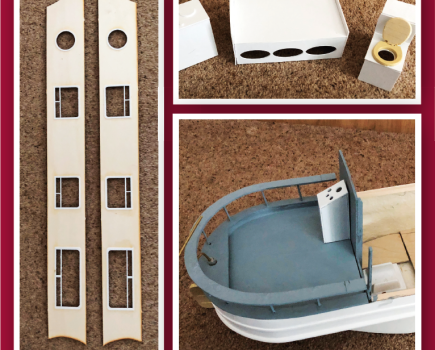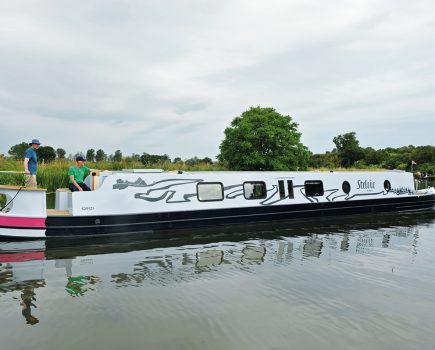France is, without doubt, one of the most beautiful countries in the world. It’s also the most visited – by 83 million people in 2012. For the boater, its size, variety of scenery and numerous, diverse waterways, make it the most popular destination in Europe.

France’s canals and rivers travel through stunning rural landscapes, dotted with lovely stone villages and towns, many of which appear unchanged through centuries.

There’s probably no better way to explore this beautiful country than by boat. What will strike you is the amount of space and the ease of travelling on uncrowded waterways. Having spent nearly four years in France in our ‘cigare Anglais’ as lock-keepers call English narrowboats, we highly recommend the experience. Measuring 950km (590 miles) east-west and almost 960km (nearly 600 miles) north-south, France is the third largest country in Europe. At nearly 550,000 square kilometres, mainland France is roughly double the size of the UK, yet the population of 66 million is only slightly greater than that of the UK. Population density is around 116 people per square kilometre, compared with the Netherlands, approaching 500, and the UK around 260 per square kilometre.

France has, of course, many wonderful cities, cathedrals, churches and chateaux, but it’s the French countryside that draws most British boaters. There are comparatively few French boats, so those you meet will almost certainly be from other countries – the UK, the Netherlands, Germany, even ‘colonials’ from New Zealand, Australia, the U.S. and South Africa.

Waterborne transport goes back a long way. A man-made link between the Atlantic and the Mediterranean was contemplated in Roman times. But it wasn’t until Pierre-Paul Riquet that such dreams became reality. Riquet’s vision, which became the Canal du Midi, is one of the world’s great engineering feats, and pre-dated the French Revolution by more than 100 years.

Today there are almost 9,000km (5,592 miles) of navigable waterways – a figure that has actually increased in recent years. Sadly, despite investment by various French governments, commercial traffic has declined and today you can travel on most popular waterways without encountering a single working vessel.
The French season is longer than the British, particularly in the south. March and April, can be cool and wet, whereas you can confidently carry on cruising through September and often well into October. Winters are cold and in Burgundy it can be -20C, so, if you’re considering living aboard through the winter, make sure you’ve organised your mooring well in advance because space in marinas fills up quickly.
Because French waterways are wider and, more importantly, deeper, you’ll cover distances more quickly than in the UK.
There are many other differences between the two countries, some of which make the French experience all the more interesting. For example, the traditional French lunch hour remains non-negotiable. Shops, especially those in rural areas, will close for at least an hour, however, they often remain open until 7pm. Most shops are closed on Sundays and Mondays. Once you get into the rhythm and pattern of French life, you’ll find yourself adapting without much difficulty. If unable to do so, you’re probably in the wrong country!
In 2003, France adopted the 35-hour week which reduced the working hours of lock-keepers and, with an increasing number of locks being automated, lock-keepers are in danger of becoming a threatened species.
Hours vary slightly from canal to canal, so check the operating hours of the canals you’ll be using. Times are widely advertised in waterway guides and on the canals themselves. There are 13 public holidays annually in France and Bastille Day, Labour Day and Christmas Day are sacrosanct, consequently locks are closed then. Our recommendation is to buy a diary listing French public holidays and make sure you check locally before setting out.
As with the other European countries, you should always carry the necessary documentation as recommended in the initial article (CB, November 2013).
In summary, other practicalities are –
Moorings: Mooring should never be a problem. Although canal bank mooring isn’t always easy, there are usually alternatives –
(a) Halte Fluviale – a small quay or mooring place, near villages and usually organised by local authorities. These sometimes have limited facilities.
(b) Halte Nautique – a pontoon or a quay, near a village or town, often with power and water. A small charge is sometimes levied.
(c) Port de Plaisance – often operated by hire boat companies or municipal authorities, these will have power and water and occasionally showers. Fuel is sometimes available.
(d) Commercial marinas – all facilities, but many are too small for narrowboats.
Locks: Many locks, particularly on popular waterways, are operated by lock-keepers. But, more and more are being automated and these work in a variety of ways –
(a) Bankside sensors – as your boat passes through a beam about 200m from the lock, the lock operation begins.
(b) Manually-operated switches, suspended on poles over the waterway, 200m or so before the lock. The crew twists the pole as the boat approaches the lock.
(c) Electronic zappers or telecommands which are issued to the boat as it enters the relevant section. These usually apply to a series of locks and are returned at the end of the section.
(d) Lockside controls, operated by twisting a rod set into the lock wall.
Some locks have pontoons near the gates where crew can be landed to prepare the lock for operation.
There’s a considerable variety of lock sizes and shapes. Deep locks on major waterways will almost certainly have floating bollards. Operation of some unmanned smaller locks, particularly when ascending, can involve a member of your crew climbing a ladder inside the lock. Not surprisingly, many women find this unpleasant. Some locks can be turbulent and it pays to run your line under a cleat without tying it off’
Several locks on the River Yonne have sloping sides, making securing a line quite difficult. Locks on the Canal du Midi are oval-shaped, meaning lying alongside with a full length narrowboat is pretty much impossible. There’s also the occasional staircase, such as the famous Fonserannes staircase at Béziers on the Midi, originally eight locks, now six.
Licensing: One licence (vignette) covers you for the whole country and can be for a variety of periods, from one day to a full year. Purchase your annual licence by the end of March and you’ll get a ten percent discount. Licences can be obtained in person, by mail or online via the Voies Navigables de France (VNF) website (vnf.fr) which has an English translation, making it very easy. The good news is that French licences remain significantly cheaper than Canal & River Trust licences. As an example, a VNF licence for any boat of more than 14 metres is euro 582 (around £485)! This is particularly good news for narrowboaters.
Electricity: Usually not a problem. For example, many of the moorings along the Canal du Bourgogne have electricity. In some instances, there can be a minor charge for these moorings, but most are free. However, do check the amperage. Although 16 amps is pretty common, we have found it to be as low at three amps.
Gas: Bottled gas, both propane and butane, is widely available. Do remember you will need European fittings and bottles.
Water: Although we occasionally had to join a couple of hoses, finding drinking water is not difficult. However, our recommendation is to fill up when you see a facility.
Fuel: Waterside fuel filling facilities are rare. There are odd waterside pumps and fuel barges, but in most areas, your only option is to buy white diesel from supermarket fuel stations, meaning cans and a trolley. The bigger the supermarket, the better the price. Note that many smaller ones do not have a cashier and accept only Carte Bleue cards (a French bank card). If your boat can take 150 litres or more, it’s sometimes possible to organise a tanker to deliver.
Pump-out facilities, Elsan disposal: Pump-out facilities are few and far between. Although legislation is in place, and pump-out facilities are slowly being installed, you could probably count the number of working ones on two hands. In 2009, we were the first boat at the huge Arsenal basin in Paris to successfully use its pump-out facilities. If your boat is fitted with a holding tank, we suggest you talk to Lee Sanitation who advertise in Canal Boat. As there are plenty of camping sites in France, you could be better off with an Elsan.
Cruising Guides, Charts, Maps: There are three major guides, printed in three languages – French, German and English. These are coloured, with details of the individual waterways, often with photographs. They are Editions du Breil, Guides Chagnon and Fluviacarte (formerly Navicarte). There are three main waterways books in English – Inland Waterways of France by David Edwards-May (Imray, Laurie, Norie and Wilson), 8th edition, 2010, Through the French Canals by David Jefferson (Adlard Coles Nautical), 12th edition, 2009 and Cruising French Waterways Hugh McKnight (Adlard Coles Nautical), 4th edition, 2005.
Chandlers: French chandlers are rarer and more expensive than in the UK. We advise carrying as many engine and boat parts as possible. It’s easy to have spare parts mailed or couriered from the UK.
Language: It is preferable to have some understanding of the French language. Although things have changed dramatically in the amount of English spoken, particularly by younger people, do not expect a local somewhere deep in rural France to understand English.
Food, Supermarkets: Shopping in France is enjoyable and very much part of the ‘experience’. Supermarkets are good, although perhaps a little more expensive than their UK equivalents. The variety in fruit and vegetables can be less. Wine and spirits tend to be cheaper than in the UK. French supermarkets do not offer plastic bags, so make sure you have your own bags for shopping. Most towns and villages still have local markets where produce will be fresh although a little more expensive. However, with tough economic times in the French countryside, many local shops such as boulangeries and epiceries have found competition from supermarkets overpowering and have closed. ATMs are not nearly as common as in other European countries, particularly in rural areas. Consequently, it pays to carry additional cash when buying groceries or fuel.
Flags, Ensigns: You should fly your national flag (usually red ensign) and a French tricolour as a courtesy ensign.
Boating community: Significant numbers of British and Dutch boats and boats from other European countries. Language is rarely a problem among fellow boaters as most will speak some English.
Safety: France is an orderly and safe country with little or no anti-social behaviour, certainly much less than in the UK. There have been occasional reports of boats being cast adrift, particularly in Charleville-Meziérès. Always make sure your boat is well secured and bicycles chained on board.
Safety equipment: Carry the same safety equipment as you would in any other European country.
Finally, a word about two waterways – the Canal du Midi and the Lot. The Midi is France’s best known and most popular canal. At its best, it’s a languid way to travel through Languedoc and its slumbering vineyards. At its worst, it’s an impossibly overcrowded waterway.
The River Lot navigation, currently in two unconnected sections, is, I believe, potentially the most beautiful cruising waterway in Europe. A long-term and significant reclamation project will eventually reconnect the two sections of this most beautiful waterway.
There’s something for everyone in France. In those immortal words – enjoy!
Image(s) provided by:
Archant







